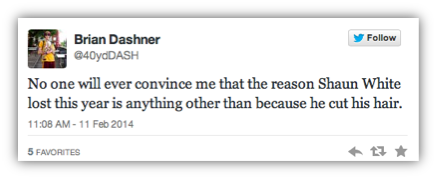
The Olympic events are viewed by more than 3.2 billion people worldwide. It is a spectacle watched by patriotic supporters who are quick to celebrate a win but faster to criticize a loss.
United by national pride, fans tune in to cheer on their athletes, a tradition that has taken place for more than 100 years. Athletes, branded by their national flags, are transformed into iconic heroes if successful or outcast as international disappointments if a mistake is made or loss occurs.
This year’s Sochi Olympics were no different. Shaun White, a two-time snowboard gold medalist in the category of men’s half pipe, was the clear favorite to win again. 24 million people from the US tuned in to watch White compete. With four years of built-up expectations, hard work and a reputation to uphold….White flopped.
So what’s a passionate and disappointed fan to do from halfway across the world?
Aggravated fans now take aim at their defeated icons on the globalized and digitized platform that is social media. Sending mean tweets and social heckles has become the rotten tomato of the modern virtual world. We’ve all read these posts with a chuckle, maybe even encouraged them with the retweet of a cruel albeit witty critique.
But how should Shaun White—a brand himself worth millions in endorsements—react?
Shaun White’s criticisms began before he lost the gold medal competition, when he pulled out of the men’s slope style competition. White deemed the course too dangerous to compete and was ridiculed both in the media and online for his decision.
Instead of lashing out at his critics, only adding fuel to the proverbial Olympic torch, White addressed the issue in a video he posted to his social media accounts. White engaged with his supporters and thanked his fans.
“You support me through the decisions I make, the training regimen… I want to do my best, not only for myself but for you guys.”
Whether you’re communicating as a brand, a business or an individual, it is best to face controversial issues and social taunts head on. Acknowledge, engage and address the issue. Below, Mambo gives guidelines for brands dealing with “The Social Heckler.”’
Mambo Guidelines:
Social Media encourages transparency. It encourages sharing. It encourages feedback. It is dependent on User-Generated Content.
It is every brand’s worst day at the office when a consumer or detractor attacks their brand or product publicly on a blog, a forum, or on twitter.com. It’s one thing if the complaint is based on experience and another if it’s baseless, untrue and vindictive.
Most marketers don’t know how to deal with a public slight. And there are degrees of hecklerhood on social media:
3rd Degree: A onetime complaint, usually through twitter.com: “Brand X sucks”
2nd Degree: A lengthy, misinformed expository comment. Most commonly, this is seen on a comment stream or a review
1st Degree: A foe actively seeking out the organization and disparaging it or its products. Tools for this include the comments section of online newspapers, an entire blog post dedicated to their grievance, or worse yet, the purchase of CompanyXsucks.com domain name that fills the first page of returns on Google.com.
Mambo Media has handled and neutralized all three levels of reputation management. Each level requires different methods, but the most important thing is to react, respond and engage. It is tempting to just ignore the slight. Don’t – most of the time, the heckler just wants to be heard.
The chart below captures the recommended strategies for each variation of the heckling:
| Degree |
Attributes |
Ways to Respond |
| 3rd | * One-time complaint* Usually on Twitter or via email*Example: “Company X sucks” | * Publicly Acknowledge* Appreciate the feedback* Indicate changes you will make, or have made as a result of the complaint |
| 2nd | * A lengthy, misinformed expository comment* Usually one comment on a blog or Yelp! Review* Ex: “This Company steals customers from local vendors, and they charge way too much. I wish my city would just ban them.” | * Publicly reply to the post, acknowledging the author’s concerns. Read:https://www.yelp.com/business/review_response* POLITELY present the facts, in a measured tone. Refer them to online third-party resources* Request an offline phone conversation, meeting, or email exchange |
| 1st | * A foe activelyseeking out * A foe actively seeking out the organization and disparaging it or its products* Usually will comment on all blogs related to the company or industry, write their own blog post, comment on news articles, and create a Facebook or webpage dedicated to their campaign.* Ex: “This organization mismanages its donations. And the people who work there don’t know what they’re doing. How do I know? I use to work there, until they fired me. But, I care about starving children in Africa and am offended they are stalling change. So, I started this blog to detail how backwards the organization is.” | * Reach out to the heckler and set up an in-person meeting.* Make it on neutral territory, preferably with others in tow. Making your heckler see that there is a human on the other line of their communiqués is critical.* Treat them like a thought leader or power-user (a valued customer). Let them vent, ideate and share their POV. Then encourage them to participate in activities related to shared goals. |
Yes, the strategies above rely on old-time “man to man” tactics. If that isn’t possible, then set up a meeting. Bring in the “bigwigs” so they realize the heights their criticism has circulated within the organization. Lastly, determine how much of this discussion is public vs. private. Each situation is different, but Mambo Media endorses transparency whenever possible.




Sorry, the comment form is closed at this time.